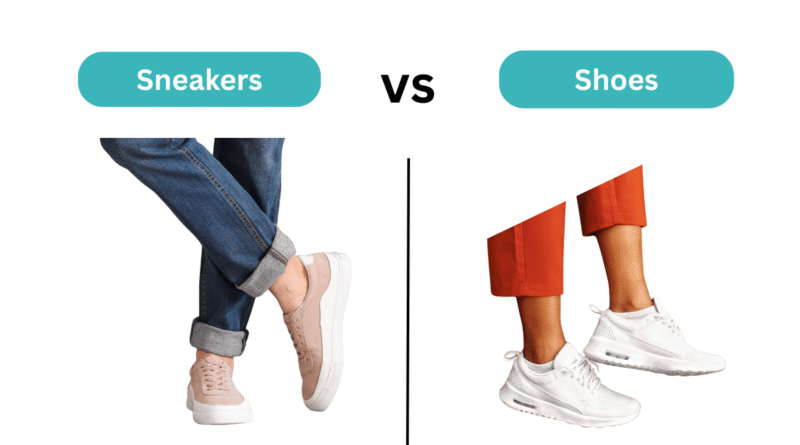Difference Between Sneakers and Shoes
Footwear transcends mere necessity; it embodies personality, comfort, and cultural significance. Whether attending business meetings or enjoying casual outings, the shoes you select leave a lasting impression. A prevalent debate among individuals is: What distinguishes sneakers from shoes?
Although numerous individuals utilize these terms as if they are synonymous, the truth is more complex. All sneakers are classified as shoes, but not every shoe can be categorized as a sneaker. Shoes include a broad spectrum of footwear, while sneakers denote a particular sub-category designed mainly for casual wear, sports activities, and comfort.
This article delves into the distinctions in detail, exploring their history, characteristics, applications, advantages and disadvantages, as well as providing answers to commonly asked questions.
The History of Footwear
Footwear ranks among the earliest inventions of humankind. Historical evidence indicates that approximately 40,000 years ago, humans began to shield their feet using coverings made from leather and plant materials. In ancient societies such as Egypt, Rome, and Greece, footwear also represented social status and authority.
As craftsmanship advanced during the Middle Ages and subsequently during the Industrial Revolution, shoes became more accessible to the general public, leading to the development of various styles—formal, casual, occupational, and athletic footwear. In contemporary society, shoes serve not only practical purposes but also reflect fashion, cultural heritage, and personal identity.
The Emergence of Sneakers
In contrast, sneakers represent a relatively recent innovation. The initial sneakers were introduced in the late 19th century, when footwear with rubber soles was developed for athletic and physical pursuits. Their soft rubber soles allowed for quiet movement, which is the origin of the term “sneakers”—as wearers could move about stealthily.
By the early 20th century, sneakers had captured worldwide interest. The Converse Chuck Taylor All Star, released in 1917, was one of the first widely recognized basketball sneakers, followed by advancements from brands such as Adidas, Puma, and Nike.
In contemporary times, sneakers have evolved beyond mere footwear—they have become a symbol of fashion, a vital component of lifestyle, and even items of collection. Limited-edition sneakers from labels like Yeezy, Air Jordan, and Balenciaga frequently command prices in the thousands of dollars.
What Are Shoes?
Footwear is defined as any kind of shoe intended to safeguard the feet, aid in walking, and enhance visual appeal. They are available in numerous styles, materials, and functions.
Key Features of Shoes:
Can be categorized as formal, casual, sporty, or protective
Made from leather, suede, canvas, rubber, or synthetic materials
Engineered for adaptability—from sophistication to rugged resilience
Frequently emphasize aesthetics, social status, and durability
Types of Shoes:
Formal Shoes: Oxfords, Derbies, Brogues, Loafers – perfect for business settings and weddings
Casual Shoes: Moccasins, slip-ons, espadrilles – suitable for daily use
Work Shoes: Safety boots, steel-toe boots, medical clogs – designed for professional safety
Sports Shoes: Football boots, running shoes, hiking boots – focused on performance.
What Are Sneakers?
Sneakers constitute a unique type of footwear that prioritizes comfort, flexibility, and a casual appearance. Originally developed for athletes, they have evolved into a favored option for daily use.
Key Features of Sneakers:
- Lightweight and breathable materials (mesh, canvas, fabric)
- Cushioned rubber soles for enhanced comfort
- Sporty, fashionable, and adaptable for various styles
- Appropriate for both athletic activities and casual daily use
Common Types of Sneakers:
- Running Sneakers
- Basketball Sneakers
- High-top and Low-top Sneakers
- Lifestyle Sneakers (such as Air Jordans, Yeezys, Converse, etc.)
Benefits of Sneakers
1) Exceptional comfort
2) Lightweight and well-cushioned
3) Perfect for extended walks and athletic activities
4) Fashionable and appealing for young people
5) Simple to match with casual outfits
Drawbacks of Sneakers
1) Shorter durability in comparison to leather footwear
2) Needs regular maintenance
3) Inappropriate for formal events
Benefits of Shoes
1. Sturdy and enduring (particularly leather)
2. Sophisticated and refined look
3. Extensive selection for various occasions
4. Appropriate for formal and traditional events
Drawbacks of Shoes
1. Certain formal footwear may lack comfort
2. Can be cumbersome and inflexible
3. Restricted adaptability for sports use
When to Choose Sneakers or Shoes
Opt for Sneakers When ;
- Engaging in casual outings or traveling
- Participating in sports, gym sessions, or fitness activities
- Walking for extended distances
- Styling streetwear or contemporary outfits
Opt for Shoes When:
- Attending formal occasions, workplaces, or weddings
- Working in industrial settings or environments requiring protective gear
- Seeking a classic, professional appearance
- Taking part in traditional or cultural events
When to Choose Sneakers or Shoes
Opt for Sneakers When:
- Engaging in casual outings or traveling
- Participating in sports, gym sessions, or fitness activities
- Walking for extended distances
- Styling streetwear or contemporary outfits
Opt for Shoes When:
- Attending formal occasions, workplaces, or weddings
- Working in industrial settings or environments requiring protective gear
- Seeking a classic, professional appearance
- Taking part in traditional or cultural events
FAQs
Q1. Are sneakers classified as shoes?
Yes, sneakers are indeed categorized as shoes; however, it is important to note that not every type of shoe qualifies as a sneaker. The term ‘shoes’ encompasses a wide range of styles, including formal, casual, sports, and protective footwear, while sneakers are mainly linked to sporty and casual designs.
Q2. What distinguishes sneakers from shoes?
The key difference is that ‘shoes’ represent a broad category that includes all types of footwear, whereas ‘sneakers’ specifically refer to casual or athletic shoes designed for comfort and physical activities.
Q3. Are sneakers more comfortable than conventional shoes?
Generally speaking, yes. Sneakers are designed with cushioning, lightweight materials, and flexible soles, which typically make them more comfortable than most formal or dress shoes.
Q4. Can sneakers be worn in formal settings?
Although sneakers are primarily casual, certain upscale “dress sneakers” can be matched with semi-formal attire. However, they are not suitable for strictly formal events such as weddings or business meetings.
Q5. Which has a longer lifespan: sneakers or shoes?
High-quality leather shoes can last for several years with proper care, while sneakers generally have a lifespan of 1 to 3 years, depending on how frequently they are used.
Q6. Are sneakers suitable for sports activities?
Yes, sneakers are often designed for sports and physical activities; however, specialized athletic footwear (like running shoes or basketball shoes) provides better support for specific sports.
Q7. What accounts for the popularity of sneakers among the youth?
Sneakers are trendy, comfortable, and versatile for everyday wear, which enhances their appeal among younger people compared to traditional shoes.
Q5. Are sneakers exclusively for casual wear?
Generally, yes, sneakers are primarily designed for casual and athletic appearances. Nevertheless, fashion brands have begun to produce “luxury sneakers” that can be paired with semi-formal attire.
Q6. Do sneakers offer superior foot support compared to shoes?
Typically, sneakers provide enhanced cushioning and arch support, making them more suitable for prolonged periods of standing or walking than most formal footwear.
Q7. Can shoes match the comfort level of sneakers?
Indeed, certain contemporary dress shoes and loafers are now equipped with memory foam or cushioned insoles, enhancing their comfort. However, sneakers generally excel in overall comfort.
Q8. What is the etymology of the term “sneakers”?
The name “sneakers” comes from their soft rubber soles, which enable individuals to walk or “sneak” around quietly without producing noise.
Q9. What categories of shoes do not fall under sneakers?
Formal shoes, boots, loafers, high heels, sandals, safety footwear, and slippers are all examples of shoes that are not classified as sneakers.
Q10. Which is more suitable for running, sneakers or shoes?
Sneakers, especially running shoes, are better suited for running because of their lightweight construction and impact-absorbing characteristics.
Q11. Are sneakers appropriate for office attire?
This is dependent on the dress code of the office. In creative or casual settings, sneakers might be permissible. On the other hand, in corporate or traditional environments, formal footwear is generally preferred.
Q12. Do sneakers wear out more quickly than shoes?
Yes, sneakers tend to deteriorate faster because they are constructed from lightweight materials and are intended for active use, such as walking or sports.
Q13. Can sneakers be washed?
Many sneakers made from canvas or mesh can be washed, while leather or suede sneakers necessitate specific cleaning techniques.
Q14. What are the reasons for the preference of sneakers over shoes?
People favor sneakers because they are lightweight, comfortable, versatile, and fashionable, making them ideal for everyday use, unlike traditional shoes that are more formal.


Pingback: Types of Sneakers: An In-Depth Guide to Style and Comfort - Fablogpublic